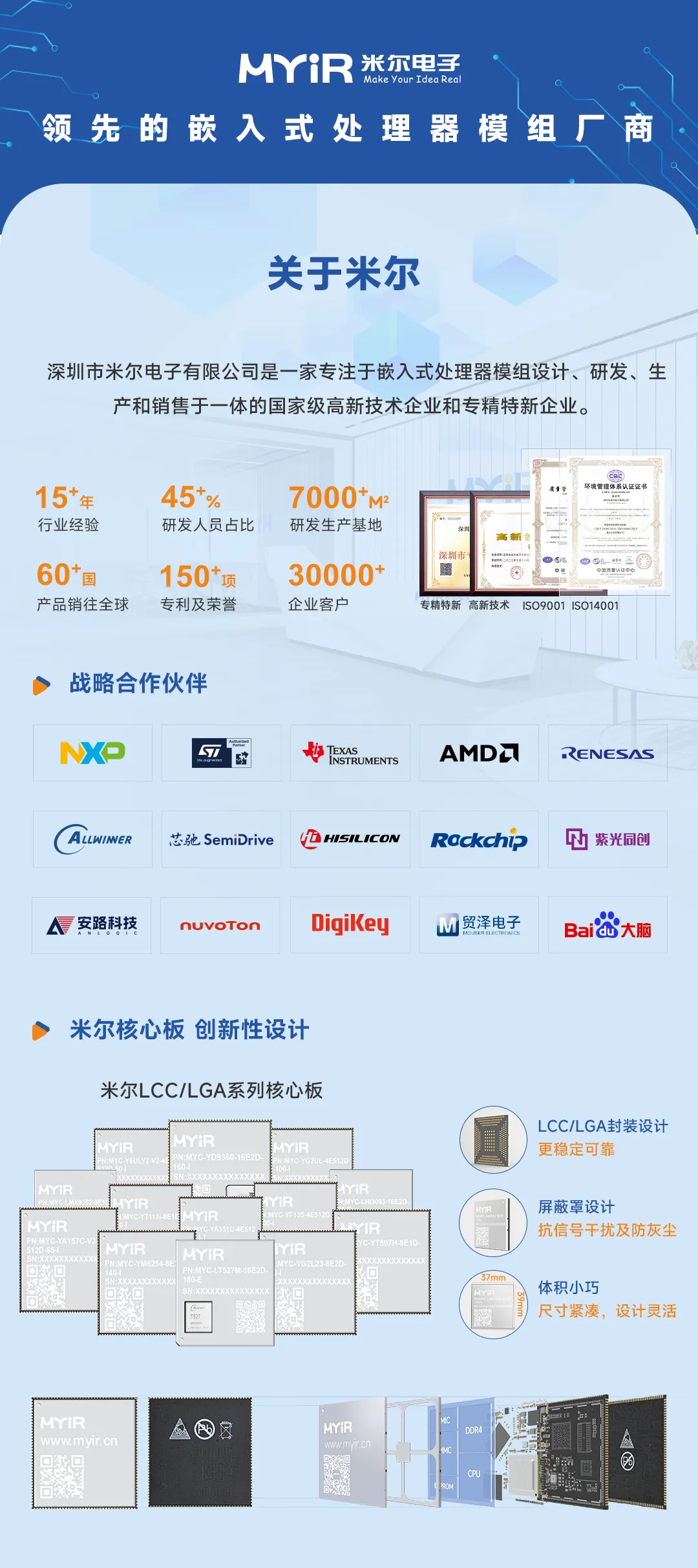
本文将介绍基于米尔电子MYD-LR3576开发板(米尔基于瑞芯微 RK3576开发板)的人脸疲劳检测方案测试。

米尔基于RK3576核心板/开发板
【前言】
人脸疲劳检测:一种通过分析人脸特征来判断一个人是否处于疲劳状态的技术。其原理主要基于计算机视觉和机器学习方法。当人疲劳时,面部会出现一些特征变化,如眼睛闭合程度增加、眨眼频率变慢、打哈欠、头部姿态改变等。
例如,通过检测眼睛的状态来判断疲劳程度是一个关键部分。正常情况下,人的眨眼频率相对稳定,而当疲劳时,眨眼频率会降低,并且每次眨眼时眼睛闭合的时间可能会延长。同时,头部可能会不自觉地下垂或者摇晃,这些特征都可以作为疲劳检测的依据。米尔MYC-LR3576采用8核CPU+搭载6 TOPS的NPU加速器,3D GPU,能够非常轻松的实现这个功能,下面就如何实现这一功能分享如下:
【硬件】
1、米尔MYC-LR3576开发板
2、USB摄像头
【软件】
1、v4l2
2、openCV
3、dlib库:dlib 是一个现代化的 C++ 工具包,它包含了许多用于机器学习、图像处理、数值计算等多种任务的算法和工具。它的设计目标是提供高性能、易于使用的库,并且在开源社区中被广泛应用。
【实现步骤】
1、安装python-opencv
2、安装dlib库
3、安装v4l2库
【代码实现】
1、引入cv2、dlib以及线程等:
import cv2import dlibimport numpy as npimport timefrom concurrent.futures import ThreadPoolExecutorimport threading
2、初始化dlib的面部检测器和特征点预测器
detector = dlib.get_frontal_face_detector()predictor = dlib.shape_predictor('shape_predictor_68_face_landmarks.dat')
3、定义计算眼睛纵横比的函数
def eye_aspect_ratio(eye):A = np.linalg.norm(np.array(eye[1]) - np.array(eye[5]))B = np.linalg.norm(np.array(eye[2]) - np.array(eye[4]))C = np.linalg.norm(np.array(eye[0]) - np.array(eye[3]))ear = (A + B) / (2.0 * C)return ear
4、定义计算头部姿势的函数
def get_head_pose(shape):# 定义面部特征点的三维坐标object_points = np.array([(0.0, 0.0, 0.0),(0.0, -330.0, -65.0),(-225.0, 170.0, -135.0),(225.0, 170.0, -135.0),(-150.0, -150.0, -125.0),(150.0, -150.0, -125.0)], dtype=np.float32)image_pts = np.float32([shape[i] for i in [30, 8, 36, 45, 48, 54]])size = frame.shapefocal_length = size[1]center = (size[1] // 2, size[0] // 2)camera_matrix = np.array([]],[]],[]], dtype="double")dist_coeffs = np.zeros((4, 1))(success, rotation_vector, translation_vector) = cv2.solvePnP(object_points, image_pts, camera_matrix, dist_coeffs, flags=cv2.SOLVEPNP_ITERATIVE)rmat, _ = cv2.Rodrigues(rotation_vector)angles, _, _, _, _, _ = cv2.RQDecomp3x3(rmat)return angles
5、定义眼睛纵横比阈值和连续帧数阈值
EYE_AR_THRESH = 0.3EYE_AR_CONSEC_FRAMES = 48
6、打开摄像头
我们先使用v4l2-ctl --list-devices来例出接在开发板上的列表信息:
USB Camera: USB Camera (usb-xhci-hcd.0.auto-1.2):/dev/video60/dev/video61/dev/media7
在代码中填入60为摄像头的编号:
cap = cv2.VideoCapture(60)cap.set(cv2.CAP_PROP_FRAME_WIDTH, 480)cap.set(cv2.CAP_PROP_FRAME_HEIGHT, 320)
7、创建多线程处理函数,实现采集与分析分离:
# 多线程处理函数def process_frame(frame):global COUNTER, TOTALgray = cv2.cvtColor(frame, cv2.COLOR_BGR2GRAY)faces = detector(gray, 0) # 第二个参数为0,表示不使用upsamplingfor face in faces:landmarks = predictor(gray, face)shape = [(landmarks.part(i).x, landmarks.part(i).y) for i in range(68)]left_eye = shape[36:42]right_eye = shape[42:48]left_ear = eye_aspect_ratio(left_eye)right_ear = eye_aspect_ratio(right_eye)ear = (left_ear + right_ear) / 2.0if ear < EYE_AR_THRESH:with lock:COUNTER += 1else:with lock:if COUNTER >= EYE_AR_CONSEC_FRAMES:TOTAL += 1COUNTER = 0# 绘制68个特征点for n in range(0, 68):x, y = shape[n]cv2.circle(frame, (x, y), 2, (0, 255, 0), -1)cv2.putText(frame, f"Eye AR: {ear:.2f}", (10, 30), cv2.FONT_HERSHEY_SIMPLEX, font_scale, (0, 0, 255), 2)cv2.putText(frame, f"Blink Count: {TOTAL}", (10, 60), cv2.FONT_HERSHEY_SIMPLEX, font_scale, (0, 0, 255), 2)# 计算头部姿势angles = get_head_pose(shape)pitch, yaw, roll = anglescv2.putText(frame, f"Pitch: {pitch:.2f}", (10, 120), cv2.FONT_HERSHEY_SIMPLEX, font_scale, (0, 0, 255), 2)cv2.putText(frame, f"Yaw: {yaw:.2f}", (10, 150), cv2.FONT_HERSHEY_SIMPLEX, font_scale, (0, 0, 255), 2)cv2.putText(frame, f"Roll: {roll:.2f}", (10, 180), cv2.FONT_HERSHEY_SIMPLEX, font_scale, (0, 0, 255), 2)# 判断疲劳状态if COUNTER >= EYE_AR_CONSEC_FRAMES or abs(pitch) > 30 or abs(yaw) > 30 or abs(roll) > 30:cv2.putText(frame, "Fatigue Detected!", (10, 210), cv2.FONT_HERSHEY_SIMPLEX, font_scale, (0, 0, 255), 2)return frame
8、创建图像显示线程:
with ThreadPoolExecutor(max_workers=2) as executor:future_to_frame = {}while True:ret, frame = cap.read()if not ret:break# 提交当前帧到线程池future = executor.submit(process_frame, frame.copy())future_to_frame[future] = frame# 获取已完成的任务结果for future in list(future_to_frame.keys()):if future.done():processed_frame = future.result()cv2.imshow("Frame", processed_frame)del future_to_frame[future]break# 计算帧数fps_counter += 1elapsed_time = time.time() - start_timeif elapsed_time > 1.0:fps = fps_counter / elapsed_timefps_counter = 0start_time = time.time()cv2.putText(processed_frame, f"FPS: {fps:.2f}", (10, 90), cv2.FONT_HERSHEY_SIMPLEX, 0.7, (0, 0, 255), 2)if cv2.waitKey(1) & 0xFF == ord('q'):

import cv2import dlibimport numpy as npimport timefrom concurrent.futures import ThreadPoolExecutorimport threading# 初始化dlib的面部检测器和特征点预测器detector = dlib.get_frontal_face_detector()predictor = dlib.shape_predictor('shape_predictor_68_face_landmarks.dat')# 修改字体大小font_scale = 0.5 # 原来的字体大小是0.7,现在改为0.5# 定义计算眼睛纵横比的函数def eye_aspect_ratio(eye):A = np.linalg.norm(np.array(eye[1]) - np.array(eye[5]))B = np.linalg.norm(np.array(eye[2]) - np.array(eye[4]))C = np.linalg.norm(np.array(eye[0]) - np.array(eye[3]))ear = (A + B) / (2.0 * C)return ear# 定义计算头部姿势的函数def get_head_pose(shape):# 定义面部特征点的三维坐标object_points = np.array([(0.0, 0.0, 0.0), # 鼻尖(0.0, -330.0, -65.0), # 下巴(-225.0, 170.0, -135.0), # 左眼左眼角(225.0, 170.0, -135.0), # 右眼右眼角(-150.0, -150.0, -125.0), # 左嘴角(150.0, -150.0, -125.0) # 右嘴角], dtype=np.float32)image_pts = np.float32([shape[i] for i in [30, 8, 36, 45, 48, 54]])size = frame.shapefocal_length = size[1]center = (size[1] // 2, size[0] // 2)camera_matrix = np.array([[focal_length, 0, center[0]],[0, focal_length, center[1]],[0, 0, 1]], dtype="double")dist_coeffs = np.zeros((4, 1))(success, rotation_vector, translation_vector) = cv2.solvePnP(object_points, image_pts, camera_matrix, dist_coeffs, flags=cv2.SOLVEPNP_ITERATIVE)rmat, _ = cv2.Rodrigues(rotation_vector)angles, _, _, _, _, _ = cv2.RQDecomp3x3(rmat)return angles# 定义眼睛纵横比阈值和连续帧数阈值EYE_AR_THRESH = 0.3EYE_AR_CONSEC_FRAMES = 48# 初始化计数器COUNTER = 0TOTAL = 0# 创建锁对象lock = threading.Lock()# 打开摄像头cap = cv2.VideoCapture(60)cap.set(cv2.CAP_PROP_FRAME_WIDTH, 480) # 降低分辨率cap.set(cv2.CAP_PROP_FRAME_HEIGHT, 320)# 初始化帧计数器和时间戳fps_counter = 0start_time = time.time()# 多线程处理函数def process_frame(frame):global COUNTER, TOTALgray = cv2.cvtColor(frame, cv2.COLOR_BGR2GRAY)faces = detector(gray, 0) # 第二个参数为0,表示不使用upsamplingfor face in faces:landmarks = predictor(gray, face)shape = [(landmarks.part(i).x, landmarks.part(i).y) for i in range(68)]left_eye = shape[36:42]right_eye = shape[42:48]left_ear = eye_aspect_ratio(left_eye)right_ear = eye_aspect_ratio(right_eye)ear = (left_ear + right_ear) / 2.0if ear < EYE_AR_THRESH:with lock:COUNTER += 1else:with lock:if COUNTER >= EYE_AR_CONSEC_FRAMES:TOTAL += 1COUNTER = 0# 绘制68个特征点for n in range(0, 68):x, y = shape[n]cv2.circle(frame, (x, y), 2, (0, 255, 0), -1)cv2.putText(frame, f"Eye AR: {ear:.2f}", (10, 30), cv2.FONT_HERSHEY_SIMPLEX, font_scale, (0, 0, 255), 2)cv2.putText(frame, f"Blink Count: {TOTAL}", (10, 60), cv2.FONT_HERSHEY_SIMPLEX, font_scale, (0, 0, 255), 2)# 计算头部姿势angles = get_head_pose(shape)pitch, yaw, roll = anglescv2.putText(frame, f"Pitch: {pitch:.2f}", (10, 120), cv2.FONT_HERSHEY_SIMPLEX, font_scale, (0, 0, 255), 2)cv2.putText(frame, f"Yaw: {yaw:.2f}", (10, 150), cv2.FONT_HERSHEY_SIMPLEX, font_scale, (0, 0, 255), 2)cv2.putText(frame, f"Roll: {roll:.2f}", (10, 180), cv2.FONT_HERSHEY_SIMPLEX, font_scale, (0, 0, 255), 2)# 判断疲劳状态if COUNTER >= EYE_AR_CONSEC_FRAMES or abs(pitch) > 30 or abs(yaw) > 30 or abs(roll) > 30:cv2.putText(frame, "Fatigue Detected!", (10, 210), cv2.FONT_HERSHEY_SIMPLEX, font_scale, (0, 0, 255), 2)return framewith ThreadPoolExecutor(max_workers=2) as executor:future_to_frame = {}while True:ret, frame = cap.read()if not ret:break# 提交当前帧到线程池future = executor.submit(process_frame, frame.copy())future_to_frame[future] = frame# 获取已完成的任务结果for future in list(future_to_frame.keys()):if future.done():processed_frame = future.result()cv2.imshow("Frame", processed_frame)del future_to_frame[future]break# 计算帧数fps_counter += 1elapsed_time = time.time() - start_timeif elapsed_time > 1.0:fps = fps_counter / elapsed_timefps_counter = 0start_time = time.time()cv2.putText(processed_frame, f"FPS: {fps:.2f}", (10, 90), cv2.FONT_HERSHEY_SIMPLEX, 0.7, (0, 0, 255), 2)if cv2.waitKey(1) & 0xFF == ord('q'):break# 释放摄像头并关闭所有窗口cap.release()cv2.destroyAllWindows()
【总结】
【米尔MYC-LR3576核心板及开发板】
这块开发板性能强大,能轻松实现对人脸的疲劳检测,通过计算结果后进入非常多的工业、人工智能等等的实用功能。

米尔RK3576开发板折扣活动火热进行中,购买链接:

米尔电子最新“明星产品”速报






